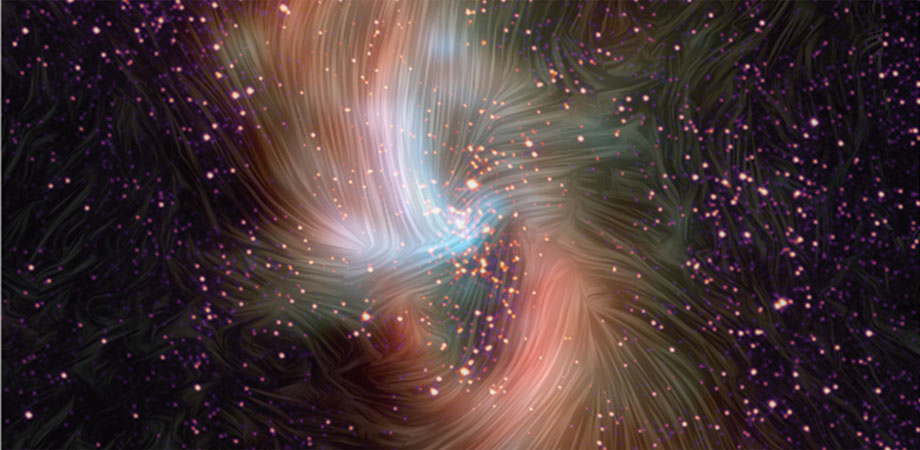Why the Milky Way’s Black Hole is a Picky Eater

Never mind the restaurant at the end of the universe, there is a diner at the center of the galaxy.
In the heart of our spiral galaxy, the Milky Way, a bright and compact astronomical radio source known as "Sagittarius A*" (Sagittarius A-Star), is considered a likely location for a supermassive black hole. Such gigantor-sized objects are believed to be at the centers of most spiral and elliptical galaxies. Black holes of this size have huge appetites, gobbling up interstellar gas, dust, stars, comets, and whatever else might be pulled in. Most black holes are highly active, emitting high-energy radiation as material is consumed. But the Milky Way's black hole is relatively quiet compared to others, and astronomers have wondered why it seems to be a picky eater.
In July 2012, NASA's Nuclear Spectroscopic Telescope Array (NuSTAR) spacecraft caught the Milky Way's black hole having a snack. An orbiting observatory, NuSTAR is designed to capture images of violent, high-energy phenomena taking place in the universe. The telescope detected a burst of hard x-rays coming from the Milky Way's center, showing that the black hole had just devoured ... something. Although this outburst was confirmed by lower-energy observations from NASA's Chandra X-Ray Observatory and infrared data from the Keck Telescope, it still didn't answer the question of why this black hole doesn't seem to consume as much as the other massive kids on the block.

NuSTAR captured these first, focused views of the supermassive black hole at the heart of the Milky Way in high-energy x-rays. Credit: NASA
Researchers suspect that invisible magnetic fields may be wrapped around some black holes. These lines of force can significantly influence the motion and evolution of matter, but since they can't be imaged directly, their role in black hole activity isn't fully understood. Using the High-resolution Airborne Wideband Camera-Plus (HAWC+), the newest instrument aboard NASA's Stratospheric Observatory for Infrared Astronomy (SOFIA), such a field was recently located at the Milky Way's black hole.
The HAWC+ detects polarized far-infrared light, invisible to the human eye, produced by grains of celestial dust that align at an angle to the magnetic fields. The new images show a structure that extends light years through space, and this may be what's keeping material from being swallowed by our black hole. These results will allow astronomers to map the shape of the field and understand the strength of this otherwise invisible force of nature.
"This is one of the first instances where we can really see how magnetic fields and interstellar matter interact with each other," says Joan Schmelz, Universities Space Research Center astrophysicist at NASA Ames Research Center. "HAWC+ is a game-changer."
Discoveries such as these made by NuSTAR, SOFIA, and HAWC+, provide multiple pieces to the puzzle of how the universe works, including the life cycles of galaxies and the black holes they host. Science is discovering not only what's on the menu for black holes, but also why some of them seem to be on a diet.
Related SPIE Content:
Making unique IR observations with an airborne 2.5m telescope
The Stratospheric Observatory for Infrared Astronomy operates from a modified Boeing 747 and enables unique spectroscopy and imaging not possible with ground-based IR observatories.
Review: far-infrared instrumentation and technological development for the next decade
Far-infrared astronomy has advanced rapidly since its inception in the late 1950s, driven by a maturing technology base and an expanding community of researchers.
SOFIA in the era of JWST and ALMA
SOFIA, the Stratospheric Observatory for Infrared Astronomy, is a joint project between NASA and the German Aerospace Center DLR to provide infrared and sub-millimeter observing capabilities to the worldwide astronomical community.
Telescope design study for the NASA stratospheric observatory for infrared astronomy (SOFIA)
A conceptual design study was performed for the proposed "SOFIA" project, which is a 2.5+ meter primary telescope to bemounted in an open port on the side of a Boeing 747 aircraft, aft of the wing.
Stratospheric Observatory for Infrared Astronomy (SOFIA)
The joint U.S. and German Stratospheric Observatory for Infrared Astronomy (SOFIA), project has been operating airborne astronomy flights from Palmdale, California since 2011
The nuclear spectroscopic telescope array (NuSTAR) high-energy X-ray mission
The Nuclear Spectroscopic Telescope Array (NuSTAR) mission was launched on 2012 June 13 and is the first focusing high-energy X-ray telescope in orbit operating above ~10 keV.
Development of the HAWC far-infrared camera for SOFIA
HAWC (High-resolution Airborne Wideband Camera) is a facility science instrument for SOFIA (Stratospheric Observatory for Infrared Astronomy).
HAWC: a far-infrared camera for SOFIA
HAWC (High-resolution Airborne Wideband Camera) is a far-infrared camera designed to cover the 40 - 300 micron spectral range at the highest possible angular resolution. Its purpose is to provide a sensitive, versatile, and reliable facility-imaging capability for SOFIA's user community during its first operational use.
| Enjoy this article? Get similar news in your inbox |
|



